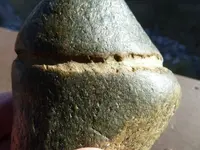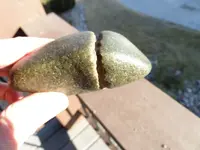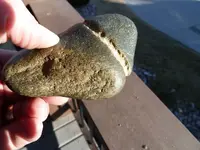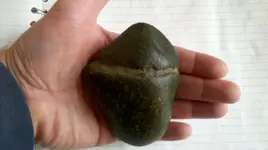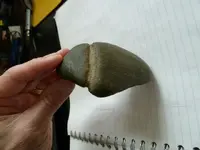You are using an out of date browser. It may not display this or other websites correctly.
You should upgrade or use an alternative browser.
You should upgrade or use an alternative browser.
Found near Grand River, Grand Rapids, MI
- Thread starter pastvne
- Start date
Indian Steve
Silver Member
Cool Rock but i don't think its a Native American made tool. Some people call them leaverites {leave it right there} but i would have took it home too. Like i said< Cool Rock. steve
Upvote
0
BosnMate
Gold Member
- Joined
- Sep 10, 2010
- Messages
- 6,916
- Reaction score
- 8,441
- Golden Thread
- 0
- Detector(s) used
- Whites MXT, Whites DFX, Whites 6000 Di Pro
- Primary Interest:
- Other
It looks to me like it's been worked, and I sure would have brought it home if I'd found it. It might be an unfinished artifact, anything from an axe to a net weight?
Upvote
0
old digger
Gold Member
I am leaning towards your item being a natural rock that contains a band of quartz layered between the darker, and harder outside rock. Being that quartz would erode sooner, thus it would appear man made. The point or edge where the two meet would be smoother, if man made. If you look closely where the two meet, there appears to be natural uneven wear. This is just what I see.
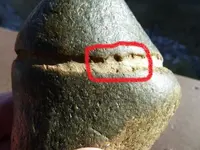

Upvote
0
pastvne
Tenderfoot
- Joined
- Feb 11, 2013
- Messages
- 2
- Reaction score
- 2
- Golden Thread
- 0
- Primary Interest:
- All Treasure Hunting
- #5
Thread Owner
Holding it in hand and rotating it, I looked to see if I could find any remnant of quartz and find none. The base of the groove and the sides of the groove appear to be the same material (sans patina) as the outside of the rock and similar in color to the flat are on the lower right corner of the above photo. I'm no geologist and not sure how probable it is that a band of quartz would occur on the rock all the way around at a uniform depth such that the ablated quartz would leave a groove of consistent depth all the way around the rock. It would seem to me, again not being a geologist, that if this effect was produced by natural removal of quartz, that we would likely not see a uniform depth of the groove since the quartz (none of which remains) would likely not have occurred in a ring-like deposit around the rock without some irregularity of depth at some point in the groove. Am I making sense?
The rock is extremely hard and dense and heavy. I've not wanted to peck-at it to test its hardness in case it is an artifact but having worked with ceramics and stone in construction, I would expect that fracturing performed with metal punch and hammer in my shop would produce a circular pitting such as shown on the edge of the groove as called out above. I do have to admit that it is hard to imagine a tool that existed in stone period that would be hard enough to fracture this hardness of rock in this way. But then I also have no expertise on what methods and materials might have been available.
The rock is extremely hard and dense and heavy. I've not wanted to peck-at it to test its hardness in case it is an artifact but having worked with ceramics and stone in construction, I would expect that fracturing performed with metal punch and hammer in my shop would produce a circular pitting such as shown on the edge of the groove as called out above. I do have to admit that it is hard to imagine a tool that existed in stone period that would be hard enough to fracture this hardness of rock in this way. But then I also have no expertise on what methods and materials might have been available.
Upvote
0
randazzo1
Bronze Member
- Joined
- Feb 1, 2006
- Messages
- 1,581
- Reaction score
- 1,746
- Golden Thread
- 0
- Location
- New York, NY
- 🏆 Honorable Mentions:
- 1
- Detector(s) used
- Whites (CM 5000, XLT, VX3) and Minelab (Svgn GT & Excal III & Equinox)
- Primary Interest:
- All Treasure Hunting
Holding it in hand and rotating it, I looked to see if I could find any remnant of quartz and find none. The base of the groove and the sides of the groove appear to be the same material (sans patina) as the outside of the rock and similar in color to the flat are on the lower right corner of the above photo. I'm no geologist and not sure how probable it is that a band of quartz would occur on the rock all the way around at a uniform depth such that the ablated quartz would leave a groove of consistent depth all the way around the rock. It would seem to me, again not being a geologist, that if this effect was produced by natural removal of quartz, that we would likely not see a uniform depth of the groove since the quartz (none of which remains) would likely not have occurred in a ring-like deposit around the rock without some irregularity of depth at some point in the groove. Am I making sense?
The rock is extremely hard and dense and heavy. I've not wanted to peck-at it to test its hardness in case it is an artifact but having worked with ceramics and stone in construction, I would expect that fracturing performed with metal punch and hammer in my shop would produce a circular pitting such as shown on the edge of the groove as called out above. I do have to admit that it is hard to imagine a tool that existed in stone period that would be hard enough to fracture this hardness of rock in this way. But then I also have no expertise on what methods and materials might have been available.
I pick up rocks like this as well because they are interesting. My initial reaction to the photographs was that we are definitely not looking at an artifac,t but rather the result of geological phenomenon. As old-digger pointed out above, the base material may have split and then mineral-bearing water pooled in the crack (imagine your rock as part of a much larger formation). As the water evaporated a layer of white mineral was left behind. Over-time, the entire formation crumbled and several pieces like this fell out. Water, wind, sand then worked together to smooth it out. The water-deposited white mineral is softer and less stable then the base material so it is eroding quicker.
But - there is a remote possibility you are looking at an actual artifact (maybe a net sinker) that was left in an environment where the man made groove around the middle was filled with another mineral (maybe calcium carbonate). I wouldn't bet the house on it, but it is possible.
The other thing that bothers me a little is that the groove doesn't appear to get wider as you get towards the surface of the stone. On a lot of grooved artifacts, the groove descends in a sort of subtle V shape around the artifact. That said - I've seen net sinkers that have a nearly U shaped groove around their entire circumference. Maybe there is a local historian or school teacher who could look at it for you.
Regardless, I would clean it till it was stable, then let it dry out and put it on my desk. It is very cool looking.
Those are my 2 cents.
Upvote
0
bigchuck52
Jr. Member
- Joined
- Feb 10, 2013
- Messages
- 30
- Reaction score
- 8
- Golden Thread
- 0
- Location
- Toms River NJ
- Detector(s) used
- Cinmaster GT
- Primary Interest:
- All Treasure Hunting
Ya know looks a little like a dinosaur tooth. The ring around it could be the gumline of the animal. There are plemty of archeological sites in the area you found that. Also many dinosaur teeth are not "RAZOR" sharp. This could be considered a molar. Still probably from a carnovour. I would send photos to an expert. Just a thought.
Upvote
0
flakebiter
Greenie
- Joined
- Mar 25, 2014
- Messages
- 15
- Reaction score
- 4
- Golden Thread
- 0
- Location
- Grand Rapids, MI
- Primary Interest:
- Other
Looks like a grooved hammerstone to me.
Here's a link to google images.
https://www.google.com/search?q=hammerstone&espv=210&es_sm=93&source=lnms&tbm=isch&sa=X&ei=-yoyU-KxPMWcyQGykoGIBw&ved=0CAgQ_AUoAQ&biw=1296&bih=732#q=hammerstone+grooved&tbm=isch
Here's a link to google images.
https://www.google.com/search?q=hammerstone&espv=210&es_sm=93&source=lnms&tbm=isch&sa=X&ei=-yoyU-KxPMWcyQGykoGIBw&ved=0CAgQ_AUoAQ&biw=1296&bih=732#q=hammerstone+grooved&tbm=isch
Upvote
0
Off n On
Full Member
- Joined
- Mar 16, 2014
- Messages
- 108
- Reaction score
- 38
- Golden Thread
- 0
- Location
- So. Cal. Orange County
- Detector(s) used
- Whites MXT 300
Bounty Hunter Quick Draw II
- Primary Interest:
- All Treasure Hunting
Looks like a grooved hammerstone to me.
Here's a link to google images.
https://www.google.com/search?q=hammerstone&espv=210&es_sm=93&source=lnms&tbm=isch&sa=X&ei=-yoyU-KxPMWcyQGykoGIBw&ved=0CAgQ_AUoAQ&biw=1296&bih=732#q=hammerstone+grooved&tbm=isch
I concur
Upvote
0
randazzo1
Bronze Member
- Joined
- Feb 1, 2006
- Messages
- 1,581
- Reaction score
- 1,746
- Golden Thread
- 0
- Location
- New York, NY
- 🏆 Honorable Mentions:
- 1
- Detector(s) used
- Whites (CM 5000, XLT, VX3) and Minelab (Svgn GT & Excal III & Equinox)
- Primary Interest:
- All Treasure Hunting
I respectfully disagree. The geometry is entirely off for a hammerstone. The groove is far too narrow and exhibits none of the widening one expects to see in groundstone artifacts. It is almost certainly a "geofact".
Upvote
0
Similar threads
- Replies
- 9
- Views
- 1K
- Replies
- 9
- Views
- 680
Users who are viewing this thread
Total: 1 (members: 0, guests: 1)
Latest Discussions
-
Have you used psychics or remote viewers for finding treasures?
- Latest: achanceforgold
-
-
-
-


